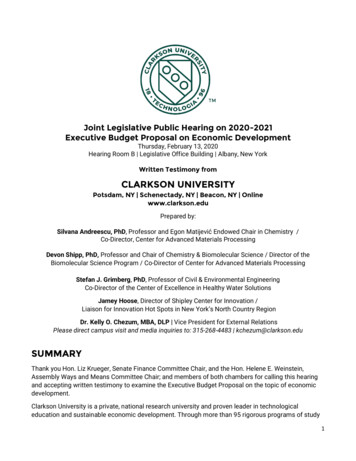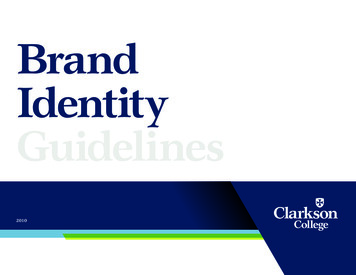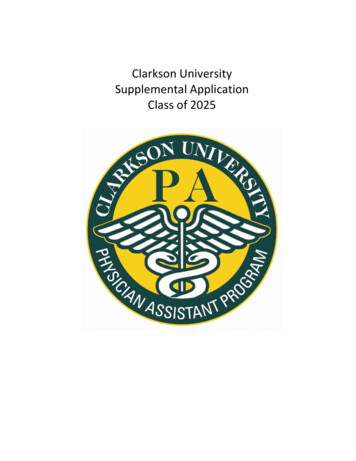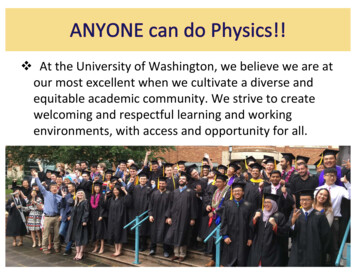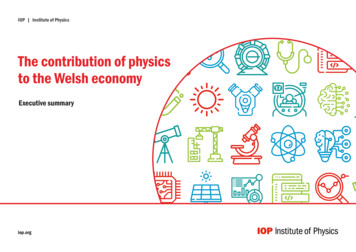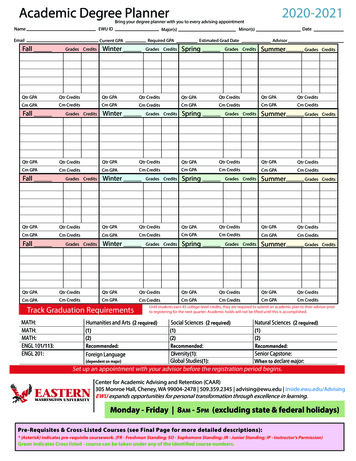
Transcription
Physics at ClarksonUndergraduate Handbook2018/2019Picture Courtesy: Professor Maria Gracheva’s Research Group
2Physics Undergraduate Handbook 2018-19
3PHYSICS AT CLARKSONPhysics Profession . 4Why study Physics? . 4What can you do with a degree in Physics from Clarkson? . 4Physics Programs and Options available . 5Structure of the Physics program at Clarkson . 5Physics – The Core Option . 6Double Major Opportunities . 6Team Design Program . 7Three-Year Accelerated Degree Program . 7Minor in Physics . 8Student-Faculty Interactions . 8Choosing your Post-Graduation Career . 9Physics Experience . 9Extracurricular activities . 9Awards . 10Employment in the Department . 10What is special about Physics at Clarkson? . 11Research Experience . 12Placement . 13The University and Location . 14Faculty Research areas . 16General Requirements for Bachelor’s Degree . 17ESL Requirement . 17Common Experience Requirements . 18Physics Undergraduate Curriculum . 23Physics Curriculum Core Option . 24Sample Curriculum for Double Major in Physics & Computer Sci. . 25Sample Curriculum for Double Major in Physics & Mechanical Eng. . 26Sample Curriculum for Double Major in Physics & Mathematics . 27Sample Curriculum for Double Major in Physics & Appl. Math. & Stat. . 28Physics Curriculum for Minors . 29Physics Bachelor’s Course Checklist . 30Physics Faculty and Their Research Fields . 32Physics Department and Admissions Contact Information . 33Physics Undergraduate Handbook 2018-19
4THE PHYSICS PROFESSIONWhy study Physics?The world is full of experiences that cry out forexplanation. Think, for example, of the colors of therainbow and soap bubbles, the vapor trails of high flyingaircraft, the fact that liquid water abruptly changes intosolid ice at a certain temperature, the production oflightning and the thunder that follows it in a storm, thebeautiful hexagonal symmetry of small snowflakes; allthis, and a limitless list of other phenomena, fall withinthe province of Physics. The essence of Science ingeneral is the observation and exploration of the worldwith a view to identifying some underlying order in whatwe find. Physics is that part of science, which dealsprimarily with the inanimate world, and is concernedwith identifying its fundamental and unifying principles.Physics is also fun and exciting.What can you do with a degree in Physics fromClarkson?Obviously, you can become a physicist. But that’s notall. Because of the flexibility in our curriculum, youropportunities are more extensive. With your degree inPhysics, you can go directly into business, industrial, orgovernmental employment, as a design, research, qualitycontrol, or development scientist or engineer;1 or, you1Recent employment data for physics graduates can be found onthe American Institute of ends.htmlPhysics Undergraduate Handbook 2018-19
5may go into the teaching profession. If you want tocontinue your higher education, you can enter graduateschool not only in Physics, but also in Mathematics,Chemistry, Engineering, Business Administration or youcan continue in a professional program such asMedicine, Dentistry, Physical Therapy, or Law.PHYSICS PROGRAMS AND OPTIONSAVAILABLEStructure of the Physics program at ClarksonThe University requires 120 credit hours (about 40courses) for graduation. Physics (or equivalent) coursesmake up 35 credit hours. For students transferring intothe Department of Physics, suitable Engineering andScience courses are accepted as equivalent to requiredPhysics courses. Similar arrangements are made forstudents double majoring with Physics. A facultymember of the Physics Department will be assigned toyou as your academic advisor. The advisor will help withyour academic needs for the duration of your studies atClarkson. Starting from selection of courses, to applyingfor graduate schools or jobs, you can consult youradvisor at any time regarding your career plans. In yourfirst year at Clarkson, you will be enrolled in a FreshmanSeminar course. This is a one-hour meeting every weekwhere you are introduced to all the members, activities,research projects, and facilities of the department.Major emphasis in the Physics curriculum is placed onundergraduate research. All faculty members are activelyPhysics Undergraduate Handbook 2018-19
6engaged in research in support of the Physics graduateprogram (offering M.S. and Ph.D. degrees). Usuallyundergraduate students identify research projects in theirareas of concentration and continue to work on theproject until graduation (following essentially the patternof graduate work). Frequently their research leads topublication in internationally recognized scientificjournals. Physics - The Core OptionThis is our broadest and most flexible option. It is suitedfor both those who want an intensive and focusedPhysics program and those who wish to diversify inareas not covered by our other concentrations. Thosepursuing the Physics core program will typically beheading for graduate school in Physics or for careers asScience teachers. Other students may want to exploit theflexibility and large number of electives in this programto follow other interests or to develop double majors. Asample curriculum is provided later in this booklet. Double Major OpportunitiesThe core Physics curriculum is flexible and allows formultidisciplinary studies.Free and concentrationelectives sum up to 28 credits. This allows Physicsmajors to double major in other fields. Recent popularchoices have included Computer Science, Mathematics,as well as Computer, Electrical and MechanicalEngineering. For illustration, some sample double majorcurricula are included in the last section of this booklet,which include Physics—and Computer Science,Mathematics, and Mechanical Engineering.Physics Undergraduate Handbook 2018-19
7 Physics Team Design ProgramThe Physics Team Design Program is centered around anadvanced laboratory experience where students aretaught mathematical modeling skills and analyticalthinking as it applies to some special projects. For aphysicist, mathematical modeling is the name of thegame! These projects are group-oriented projects thatcover such topics as modeling the motion of a toy car(on a long and adjustable track) and modeling the motionof an electric train (powered by a charged capacitor).Although the subject matter covers the physics of toys,the actual projects are quite challenging and structured tobe competitive! Teams of four students typically workfor a period of 10-12 weeks before entering into theChallenge Sessions, a series of competitive challengesand obstacles that must be carefully examined to insuresuccess. The Challenge Sessions provide a grand finaleto the semester long project with a fun but competitiveatmosphere. Three-Year Accelerated Degree ProgramThe three-year program is available to students whoenter Clarkson University with excellent preparationfrom high school. The challenging pace of this programwill require harder work and special dedication. Studentswill have the opportunity to complete their degree in ashortened time span, realizing savings in educationalcosts, and enter the job market a year earlier.Students are expected to earn 108 credits by taking onaverage six courses per semester. The remaining 12credits would be drawn from a combination of advancedPhysics Undergraduate Handbook 2018-19
8placement (AP) credits from high school and courseworktaken during summer sessions. The student must sign upto enter in this program. Minor in PhysicsFor those majoring in other fields, having an interest inPhysics, and wishing this to be recognized on theirtranscript, the Physics minor program is an option. The24-credit course of study for this option is described inthe last section of this booklet. A minimum 2.0 averagemust be maintained in these courses and none can bedesignated pass/no entry. The minor should be initiatedby the beginning of the junior year to allow time tocomplete the necessary coursework. Student-Faculty InteractionsThe student-to-faculty ratio in our undergraduate physicsprogram typically stays around 5:1. This promotes aninformal, relaxed atmosphere for learning. The smallclass size allows each student to get close attention fromthe instructor. You can approach any of the professors,not just your academic advisor, for advice. This way,often through informal conversations, you can learnabout each professor’s research subject. It often happensthat you can get involved in this research in a meaningfulway and our faculty is always on the lookout for aspectsof their research in which undergraduates can contribute.Several of our students have benefited from the program“Research Experiences for Undergraduates” (REU)funded by the National Science Foundation.Physics Undergraduate Handbook 2018-19
9 Choosing Your Post-Graduation CareerThe Clarkson Career Development Center helps you findprospective employers and arranges for on-campusinterviews with them. More importantly, throughoutyour four years at Clarkson, Physics faculty memberscan be called on to help you design your futureprofessional career.It is likely that by the end of your junior year at Clarkson(after being exposed to significant amounts of coursematerial and research work) you will develop a taste fora certain type of career. Our professors can help youexamine the “real-world situation” of the profession youlike. They can guide you in choosing the graduateschools (if you decide on graduate studies) suitable foryou and your interests. They can also help you preparefor the GRE (Graduate Record Examination: it is similarto the SAT but it is on the material you learn in collegeand it applies to your admission to a graduate program).The GRE is offered internationally. Therefore, even ifyou do not choose to attend a graduate school, your GREscore may serve as an indicator of your academicstanding on an international scale. Our PhysicsDepartment will provide you with sample GRE testsfrom the past and information on the various Physicsgraduate programs in the country.PHYSICS EXPERIENCE Extracurricular ActivitiesYou probably already know about the various funactivities and sports events at Clarkson. In addition toPhysics Undergraduate Handbook 2018-19
10these, the Physics Department offers a number ofextracurricular activities. The Clarkson Physics Club isrun entirely by students with advisor guidance directedby Professor Joshua Thomas. It sponsors student projectsand oversees operation of the Clarkson Observatory.This is a motorized, revolving dome on the outskirts ofPotsdam, housing several telescopes for doing seriousastrophotography. During the club meetings a professormay discuss a timely development in science or you mayget to watch a science documentary movie. Recently thePhysics Club has expanded its horizon by publishing itsown Journal. Participation in the Clarkson Chapter ofSigma Pi Sigma (the national Physics honor society) isalso quite popular among the students. AwardsSome of the prizes and awards applicable to all Clarksonstudents are listed in theUniversity Catalog. Inaddition, the Physics Department offers three annualawards: (1) Freshman Award, to the freshman studentmajoring in Physics who demonstrates the greatestproficiency in Physics. (2) Senior Award, to the seniorPhysics student showing the most promise for asuccessful professional career. (3) S. Arajs Award foroutstanding performance in freshman physicslaboratories. Employment in the DepartmentPhysics seniors and juniors have opportunities to work asgraders, teaching helpers, proctors, and lab instructors.Cooperative programs and similar, typically semesterlong, employment options, including those at NationalPhysics Undergraduate Handbook 2018-19
11Laboratories, are available to students with an excellentacademic record. Sometimes you may find summeremployment within the Physics department. Usually thejob involves assisting a faculty member in research, andyour task may well be a continuation of your ownresearch project. What is special about Physics at Clarkson?Facilities: The instructional and research facilities ofthe Clarkson Physics Department offer you the advancesin modern technologies. Here you can learn about thetechnologies by using them and not just by reading aboutthem. You can gain hands-on experience in large scalecomputing, photovoltaic devices, biosensors, optical andelectronic signal processing, computer interfacing, dataacquisition and processing, scanning probe microscopyand surface spectroscopy. The technical skills you gainby using these facilities can significantly boost yourposition in a competitive job market in Science andEngineering.In addition to the technical facilities, the departmentoffers a colloquium every week. Well-known scientistspresent results of their most recent discoveries. Byattending these seminars, you gain a broad perspectiveabout today’s world of science. Recent colloquiumtopics have covered a variety of most modern advancesin Biological Physics, Atomic Force Microscopy,Photovoltaic Devices, Lithium Ion Battery Technologies,Percolation Models, Statistical Physics, and PhysicsEducation.Physics Undergraduate Handbook 2018-19
12Research Experience: Many of the technical facilitiesdescribed above are tied in with the department’sgraduate research program. You can get direct access toour departmental research facilities as early as yoursophomore year. Colleges without a graduate Physicsprogram are often unable to offer such facilities. On theother hand, the large number of graduate students,postdoctoral researchers and technicians dominatesgraduate research at many other universities. Incomparison with such places, Clarkson undergraduatesplay a much larger role in the overall life of uate students allows for researchparticipation by the undergraduates. This also promotes aclose student-faculty relationship and the undergraduatesget to work side by side with their graduate colleagues,under the direct supervision of the faculty members.Such a strong research program for undergraduates isone of the most attractive features of our PhysicsDepartment.Why do research as an undergraduate? For a variety of jobs your research experience makesyou a better candidate than someone without aresearch background.The technical, communication, and computationalskills you acquire through research are obviouslyimportant for your post-graduation career. Inaddition, there is more to it:By participating in research, you can attend regionaland national conferences. There you can take aPhysics Undergraduate Handbook 2018-19
13 closer look at the current activities in the areas ofyour interest; you will know who is doing what andwho is interested in hiring people like you.With the recommendation of your facultysupervisor, you may get a chance to spend asemester at one of the prestigious NationalLaboratories. There you can make more contactswith prospective employers. Moreover, theexperience you gain in such a laboratory can becomean impressive feature of your resume. In the recentpast, our Physics majors have worked at BrookhavenNational Laboratory, atArgonne NationalLaboratory, and at Los Alamos National Laboratory.By working with the graduate students on a regularbasis, you get a first-hand view of life in a graduateschool and the general format of graduate research.This experience can help you decide whether youshould look for a graduate school or for a job aftercollege.Placement: Traditionally, Clarkson Physics graduateshave been extremely successful in competitiveemployment as well as in top ranking graduate schools.For instance, in the recent past, they have been employedby AT&T, IBM, General Electric, General Dynamics,Hewlett Packard, Texas Instruments, Intel, AnalogDevices, Eastman Kodak, US Air Force, LawrenceLivermore Laboratory, and Naval Research Laboratory.Some of our recent graduates have gone to graduateschools at Cornell University, Stanford University,University of Illinois, University of Chicago, UniversityPhysics Undergraduate Handbook 2018-19
14of Rochester, Georgia Tech, Rice University, CarnegieMellon University and Rensselaer Polytechnic Institute.More details on placement information can be obtainedfrom the University Alumni Office.The University: Founded in 1896, Clarkson is a small,independent university, long recognized for its strongreputation in technical and scientific programs. Clarksonis distinguished by three major characteristics: theexcellence of the faculty, the professional orientation ofthe curricula, and the friendliness of the people. All thePhysics faculty hold Ph.D.‘s and many of the facultyhave won national and internationalhonors andrecognition for their research and scholarship.Location: Potsdam, New York, is an attractive village of10,000 residents located along the banks of the RaquetteRiver on a rolling plain between the Adirondack forestand mountain preserve (10 mi. south) .The St. LawrenceRiver and Great Lakes Navigational Seaway System ofLocks (25 mi. north) is another tourist attraction. Visithttp://www.greatlakes-seaway.com. For the outdoorenthusiast, opportunities for fishing, hiking, climbing,boating, golfing, camping, swimming, tennis and skiingthroughout the area are endless. Clarkson students havetaken advantage of their neighboring majestic naturalenvironment of the Adirondack Park just a few milesfrom campus. The high peaks, valleys, rivers, lakes,woods, and wetlands are always awaiting the outdoorenthusiast.There are two liberal arts colleges close by: PotsdamPhysics Undergraduate Handbook 2018-19
15College of the State University of New York, and St.Lawrence University in nearby Canton. For those whooccasionally wish to avail themselves of the activities ofa large city, Potsdam is 100 miles from Montreal,Quebec; 90 miles from Ottawa, Ontario; 130 miles fromSyracuse, New York; and 80 miles from Lake Placid,New York.The Department of Physics offers accredited M.S. andPh.D. programs. The master’s program has a non-thesisoption. Diverse faculty research interests presentstudents with a variety of research possibilities fundedboth by federal agencies, such as the National ScienceFoundation, and private sources. The low student-tofaculty ratio has made it possible to maintain an intimateand friendly atmosphere and a strong tradition ofundergraduate and graduate research participation.Undergraduate students work, side by side, withgraduate students on a variety of research projects.Several faculty members of the physics department areclosely involved with materials research that representskey focus areas of the Center for Advanced MaterialsProcessing (CAMP). Physics Education representsanother strong and active research component of ourdepartment. Campus computing facilities include anetwork of mainframe computers, workstations and PCs.The Office of Information Technology (OIT) providescampus-wide, high-speed computing power.22OIT web site: hysics Undergraduate Handbook 2018-19
16FACULTY RESEARCH AREASPRIMARY THEORETICALRESEARCH AREAS Reaction kineticsSurface adsorptionNonlinear opticsCondensed and softmatter physicsTransport propertiesEffects of disorderStatistical mechanicsPhase transitionsScaling and finite sizeeffectsSurface and interfacephysicsQuantum dotsPlasmonicsPRIMARY EXPERIMENTALRESEARCH AREAS Biological physicsBiological sensorsSurface & interfacephysicsElectrochemicalimpedance spectroscopyPhysics educationLinear & nonlinearopticsEnergy storage andconversion devicesChemical mechanicalplanarizationPhotovoltaic devicesPhysics Undergraduate Handbook 2018-19
17GENERAL REQUIREMENTS FOR THE B.S.DEGREE1. At least 120 credit hours2. At least a 2.000 cumulative average3. At least a 2.000 cumulative average in the majorfield of study for the Class of 2004 or later4. Meet the requirements of the Clarkson CommonExperience5. Meet the requirements for a degree program asdetermined by the offering department or school6. A student entering as a first semester freshmanmust be in residence for at least four semesters,including the final undergraduate semester7. If entering with advanced standing, a student mustcomplete at least half the remaining upper-levelundergraduate work in residence at Clarkson. Theprogram must include a minimum of two semesters(30 credit hours) including the final undergraduatesemesterESL REQUIREMENTStudents for whom English is a second language musttake an English language placement examination uponentering Clarkson. Based on the outcome of thisexamination, a student may be required to complete oneor more ESL course(s) prior to enrolling in the ClarksonSeminar or any course assigned one or twocommunications.Physics Undergraduate Handbook 2018-19
18CLARKSON COMMON EXPERIENCE (CCE)REQUIREMENTS3I. FY 100 First-Year Seminar(1 Credit): Offered in the fall semester, requiredonly for first-year students.II. UNIV 190 The Clarkson Seminar(3 Credits): Offered each semesterIII. Knowledge Areas (KA) and University CoursesReqd. 4 more KA courses from the list below to cover 2more knowledge areas (15 total credits of KA):1. Cultures and Societies (CSO)2. Contemporary and Global Issues (CGI)3. Imaginative Arts (IA)4. Science, Technology, and Society (STS)5. Economics and Organizations (EC)6. Individual and Group Behavior (IG).3All students must take at least one University Course after the firstyearPhysics Undergraduate Handbook 2018-19
19IV. Mathematics, Statistics, Science and Technology Courses18 credits of Mathematics, including MA 131, MA 132, MA 231,MA 232, plus 3 credits of Probability/Statistics from: MA 381,STAT 381, STAT 383, MA 381, etc.Non-STAT Subject Area Courses that Satisfy theStatistics Requirement of Clarkson Common Experience 10330381382409424429430327380Course TitleBiostatisticsGeographical Info eringLaboratoryAdv Engineering MathematicsProbabilityMathematical StatisticsDS in Probability & StatisticsSeminar in AnalysisSem in Probability & StatSem in Probability & StatExperimental Physics IResearch Methods“Science” course requirements do not separatelyapply to Physics Majors3 credits of Technology Elective. Typical TECHcourses taken by Physics Majors: ES 260, CS 141,ES 300, PY 456, etc.Physics Undergraduate Handbook 2018-19
20V. Communications At least 6 Communication Points (C-1/C-2 coursescombined) are required At least 2 Communication Points (two C-1 or 1 C-2)must be earned in Physics through courses at the 300or 400-level (PH 327, PH 445-446)VI. Physics Professional Requirement This involves taking a series of courses thatincorporate professionalism, ethics, and diversity inits undergraduate curriculum. These courses are taken throughout the four years ofthe physics undergraduate program with coursesranging from 100- to 400-levels. Unlike the otherCommon Experience requirements, the courses takenunder this specific category can be used to satisfyother requirements. PH 121, PH 232, PH 327, PH 331 [these representpart of the Core Curriculum] 3 Credits from the list: PH 445, PH 446, PH 470-477[these are the Physics Professional Electives]VII. Physics Professional ExperienceThis requirement focuses on project-based professionalexperience such as co-op, internship, directed research, orcommunity project clearly related to the student’s professionalgoals. To meet this requirement, a Physics Major student willtake one course (at least 1 credit) from one of the followingthree categories: Senior Thesis -- PH445, Senior ThesisDirected Research -- PH478, Directed Research inExperimental Physics; PH479, Directed Research inPhysics Undergraduate Handbook 2018-19
21 Theoretical PhysicsInternship/Co-Op – PH480, Internship/Co-Op inPhysicsVIII. Physics Professional Elective, InformationTechnology and BiologyThese are requirements set forth by the Physics Department Physics Professional Elective (see Category IV underCCE): This course is just part of the CCE ProfessionalRequirementTypical Info Tech classes (only 1 required) taken byPhysics Majors include: CS 110, IS 110, CS 141, CS 142,etc.Typical Biology classes (only 1 required) taken byPhysics Majors include: BY 110 (without the lab BY112), BY 222 (C-1), BY 280, etc.Here are some useful notes about the CCE: A same course cannot be used to simultaneously satisfymore than one CCE requirementCommon Experience Courses are listed on SAS web siteCurrently available Communication Points courses inPhysics: PH 232 (C-1), PH 327 (C-2), PH 445 (C-2) andPH 446 (C-2)Both Professional Requirement and ProfessionalExperience are included in the CCE, and representseparate categories as described above. ProfessionalRequirement is a sequence of courses spread out over fouryears (most of which already are included in the CoreCurriculum) including at least 3 credits of PhysicsProfessional Elective (research/directed study class).Professional Experience requires at least 1 credit from PHPhysics Undergraduate Handbook 2018-19
22 445/446, PH 478/479 or PH 480Double majors may be able to use a single ProfessionalExperience (obtained through one of the two majors) tocover the requirements for both majors.Details should be discussed with the student’s academicadvisor.Physics Undergraduate Handbook 2018-19
23PHYSICS UNDERGRADUATE CURRICULUMRequired Courses*HoursCreditFirst Year Seminar . 1Clarkson Seminar . 3Physics1 (or equivalent) . 35Mathematics . 18Chemistry . 8Biology Elective . 3Communication Elective (C2) . 3Knowledge Area and University Course Electives . 15Concentration Electives2 . 9Information Technology Elective . 3Technology Elective . 3Free Electives (including one C1 course3) . 19Total . 120* Some non-credit courses in physical education, aerospace studiesand/or military science might be required for graduation.1Including the core courses, PH 131, PH 132, PH 221, PH230, PH231, PH 232, PH 325, PH 327, PH 331, PH 380 and at least 1 creditProfessional Experience selected from the variable credit coursesPH 445, 446, PH 470-471, andPH 474-477.2All these must be in one area outside Physics; an area need not bea department.3At least one of the free electives should be a [C1] or [C2]designated Communication Intensive Course unless a [C1] course isalready included in the Biology or Concentration electives.Physics Undergraduate Handbook 2018-19
24Physics Curriculum (Core option)Fall 1CoursePH 131 Physics IFirst-Year SeminarMA 131 Calculus ICM 131 Chemistry IClarkson SeminarPH 121 Phy Freshman SeminarFall 2PH 231 Modern PhysicsPH 232 Modern Phys LabMA 232 Differential EqBiology Elective or PH 230Knowledge Area/ Un
Physics, and wishing this to be recognized on their transcript, the . Physics minor. program is an option. The 24-credit course of study for this option is described in the last section of this booklet. A minimum 2.0 average must be maintained in these courses and none can be designated pass/no entry. The minor should be initiated
